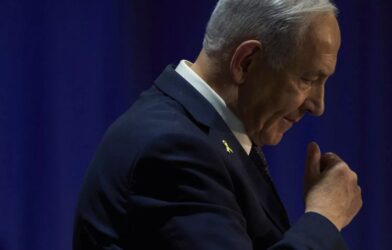
On April 7, United States President Donald Trump met Israeli Prime Minister Benjamin Netanyahu for a second time since his inauguration. Speaking to the media, Trump doubled down on his earlier comments about the Gaza Strip, describing it as an “incredible piece of important real estate”.
Trump also repeated his suggestion that the Palestinians should leave the Strip “to different countries” and claimed that people “really do love that vision. … A lot of people like my concept.”
Days later, about 70 percent of Gaza had been turned into a “no-go zone” for Palestinians. Confirming that Israel is working “in accordance with the US president’s vision, which we seek to realise”, Israeli Defence Minister Israel Katz declared Israel’s intention to “seize” more territory, adding that “wilful passage” will be given to Palestinians who want to leave.
It is by now clear that Trump’s statements on Gaza have had the effect of legitimising a longstanding Israeli vision of ethnic cleansing of the Strip. What the US president calls “my concept” is in fact not his at all.
Over decades of Israeli occupation and colonisation of the Gaza Strip, there have been multiple plans to empty out or disperse the Palestinian population in a bid to secure full control over this part of Palestine. The power of colonial practices has also been tested. For example, to draw Israeli settlers and thereby help transform Gaza’s demographics, the Strip was at one point even promoted as the “Hawaii of Israel”.
Left out of Israeli war aims in the 1948 Arab-Israeli War, the Gaza Strip emerged out of the 1949 Armistice Agreements under Egyptian military rule. Constituting only a small part of what until then had been the Gaza District of Palestine, the Gaza Strip was home to two groups of Palestinians: the local population and refugees – people who had been forced off their land as Israel expanded its territorial reach during the war.
As the guns fell silent, the Gaza Strip became known in Israeli policy circles as the “job unfinished” – a slice of land next to the Egyptian border that Israel’s leaders would like to control, preferably without its Palestinian population.
Israel’s first attempt to take Gaza by force occurred in 1956. But under pressure from US President Dwight Eisenhower, Israeli Prime Minister David Ben-Gurion had no choice but to withdraw and put an end to the Israeli occupation. The botched attempt taught Israel an important lesson: To redraw the map of the Middle East and to make its territorial expansionist agenda a success, Israel needed American support and approval.
The 1967 Arab-Israeli War was far more successful in this regard. Through conquest and occupation, the Gaza Strip was brought under direct Israeli rule. This opened the door to revitalise “transfer” – the forced displacement and ethnic cleansing of Palestinians. Seen as both necessary and permissible or, in Ben-Gurion’s words, “an important humane and Zionist idea”, transfer was recognised as an effective tool to advance Zionist colonisation of Palestine.
In the following years, as noted by Palestinian historian Nur Masalha, transfer acquired different labels. These included “population exchange”, “Arab return to Arabia”, “voluntary emigration” and “rehabilitation” with different Israeli governments taking different approaches.
One approach was Defence Minister Moshe Dayan’s “open bridges”, which allowed Palestinians in Gaza to leave for other countries in search of work. Another was to open offices in Gaza’s refugee camps to organise and pay for travel and passports for Palestinians willing to “voluntarily migrate”, which in effect turned the Israeli Ministry of Foreign Affairs into a “global travel agency”. Regardless of the approach, Israel’s policy objective remained the same: to create a drive in Palestinians to leave the Strip.
“I want them all to go, even if they go to the moon,” Israeli Prime Minister Levi Eshkol said. Expressing Israeli frustration, Eshkol articulated the feeling of being stuck with what was considered the problem of Gaza. After all, only the Palestinian population there – and the sizeable refugee population in particular – stood in the way of full Israeli annexation.
In response to Israel’s Gaza “dilemma”, its politicians also looked for more comprehensive solutions. This led to an almost continuous flow of plans for the “rehabilitation” of Palestinians outside the Strip. Starting immediately after the 1967 war, a variety of potential destinations came up. These included the West Bank, the Sinai Peninsula, Iraq, or even as far afield as Canada and Australia.
Despite Israeli efforts and elaboration of plans – and much to the disappointment of Israel’s decision-makers – the initiatives came to naught as the number of Palestinians leaving the Strip remained limited. And given other considerations, including moral, legal and diplomatic ones, the plans to displace a large number of Palestinians from Gaza were left in the drawer.
But as Israeli politicians turned to examine their menu of choices in the post-October 7, 2023, era, “voluntary emigration”, or forced displacement, re-emerged. Gone was any sensitivity to international opinion and potential reactions. Instead, Trump has led the way, making statements on Gaza that in effect turn decades of Zionist ideology and practice into official American policy.
By means of his policy stance, the US president has legitimised a longstanding Israeli vision of ethnic cleansing in the Strip. In the process, his articulation of policy has moved ever closer to the strand of Revisionist Zionism that viewed Palestinians as aliens in their own land and, therefore, “transferable”.
In arguing that Palestinians need to go to make Israel and the region safe, Trump has departed from the internationally shared principle that Palestinians in the Gaza Strip – as elsewhere in the occupied Palestinian territory – have legitimate rights to self-determination in their land. As such, Trump brings to mind Revisionist Zionist ideologue Ze’ev Jabotinsky, who argued that “when the Arab claim is confronted with our Jewish demand to be saved, it is like the claims of appetite vs the claims of starvation” with “transfer” inextricably linked to Jewish rights to the land.
The cynical promises of a better future for people who are left with nothing but their land after a brutal war of erasure and plausible genocide must be taken seriously. The legitimacy Trump has given to Israeli plans poses a threat in the here and now, but it could also outlast his presidency.
That is because he has offered US presidential sanction of ethnic cleansing as an acceptable tool. This leaves the door open for Israel – in the near or distant future – to pursue “transfer”, “rehabilitation” and “voluntary emigration” of Palestinians, whether in Gaza or the West Bank.
Furthermore, the American president has repeatedly communicated US support for illegal land seizures and colonisation. Suggesting Gaza (and Greenland) could become “US territory”, he has reintroduced and validated ideas that most leaders of the world had put on the scrap heap of history.
Finally, Trump has shifted the US position away from the premise of working towards a two-state solution. In fact, considering his statements, there appears to be a fundamental disregard for Palestinians in Gaza and their collective right to self-determination.
Looking at current US policy against historical record, Trump’s “Riviera of the Middle East” seems a curious combination of Zionist ethnic cleansing under the “transfer” model and the colonial ideal of the “Hawaii of Israel”.
It is no wonder Trump has been cheered on by Israeli leaders as he calls for the forced depopulation of the Gaza Strip and its transformation into fully fledged colonial territory – annexed or otherwise. After all, Trump’s ideas follow in the footsteps of Zionist leaders from Ben-Gurion to Netanyahu, under whom transfer has been the preferred but diplomatically and legally challenging option all along.
With Trump going out in front, such challenges could turn into tomorrow’s opportunities. It remains the task of other states to stand up against Israeli-American normalisation of continued ethnic cleansing and colonial land grabs in Palestine.
The views expressed in this article are the author’s own and do not necessarily reflect Al Jazeera’s editorial stance.





